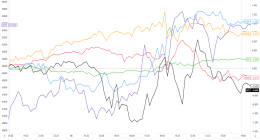
Twomey CEO David Duncan talks about letting your brand grow and flourish under the radar.
December 18, 2019 6 min read
If you like wine with a story, pull up a chair and drink in the tale of Twomey. Twomey first made waves in its early days when legendary critic Robert Parker called their Bordeaux-style 2002 Merlot “a sexpot of a Merlot.” That’s hard to beat, but it is Twomey’s nine Pinot Noirs that have really brought it into the spotlight by bridging the flavors of America’s top regions: California and Oregon.
This year marked Twomey’s 20th anniversary, and now here’s the very interesting part of their story: Twomey is actually second offering from the Duncan family of Silver Oak fame, intended to fly below the radar as long as possible. We talked to CEO David Duncan about the creation of a second cult brand and the recipe for success in winemaking.
Why did you create a second brand with Twomey, since Silver Oak was already so popular?
It was about trying something very different. Silver Oak was founded with the vision to make only one varietal—Cabernet Sauvignon. We created Twomey to explore other grape varietals that hail from unique and expressive vineyards.
Related: How a Band of Green Berets Went From Elite Warriors to Elite Bourbon Makers
With two brands, we had the opportunity to bring to life a different part of our personality and wine palate: Where Silver Oak is about Cabernet Sauvignon and American Oak, Twomey is about Pinot Noir and French Oak. Where Silver Oak is an established icon, we allowed Twomey to grow quietly and embody our exploration of exciting new wine regions and approaches. This slow-build also lets the first wave of fans be on the inside of a secret, which is a really special relationship to have.
What are the keys to successfully building a cult wine brand?
For a brand to be memorable, its product has to evolve from vintage to vintage, but maintain a consistent and recognizable signature. It is also really important that the people curating your category understand the brand is bringing a distinct approach to the craft. In our case, we need to do a good job of clearly communicating Twomey’s unique perspective to chefs, wine stewards and somms.
Distribution is really key to how consumers discover the brand because the way they find your wine is a big part of the opinion they form. We place a big emphasis on having our wine served at special restaurants for this reason: Consumer association of wine with their memorable dining experience. Interesting fact: 98% of wine is consumed within four hours of purchase.
Extending beyond wine, what is your advice to other people conducting business in a crowded industry? How do you stand out?
There are a few ways to stand out beyond your category. First, map out all the affinities of your customer beyond just your product. This will help you understand how to complement those interests. It also shows you the use-cases your brand is actually living in, and of course, the places your brand should be showing up.
Related: How to Be Your Own Boss and Drink on the Job
It’s also essential that you embrace the other brands in your industry. I know it seems counterintuitive, but if you’re communicating and partnering across your category, then you’ll have a better understanding of how to differentiate. Also, your “competitors” will actually then send customers your way when you’re the best fit — and vice versa. Who doesn’t want to work in an industry built on positive energy?
Finally, network outside of your industry. People from every category will offer a different and new perspective on how to approach your business, and you’ll be surprised at the organic energy and opportunities that arise. For me, the Young Presidents’ Organization (YPO) has been an incredible resource for expanding my business world-view.
How has the wine business changed? What trends do you see in buyers?
First of all, millennials are now the largest consumer of wine in the world. This wine drinker is very focused on finding a wine that will be an experience to drink with friends. They care about craft, sustainability, and above all else — a wine that will be memorable to share with friends. I think the “experiences” trend people are talking about is real, and I think to add on to it, there’s a real focus on “shared experiences” with friends and family. That can constitute a trip or event with fun people, but it also can mean enjoying food and wine at home with a group.
Related: MMA Champion Conor McGregor Launches Irish Whiskey Brand
Interestingly, we’re seeing millennials trading up really quickly into the super-super premium space. This is the first generation of wine drinkers whose parents were into fine wine, so they’ve inherited good taste, and when you combine that with an ability to use digital and social to research, and also a foodie sensibility and experience spending money on craft spirits.
Within the industry, selling wine direct online is really changing the game. You have more touchpoints with your consumer, more granular analytics to identify and reach customers in new areas and more flexibility for people to gift your product more seamlessly.
What marketing techniques have you found the most success with?
In the wine category, consumers want to learn with every glass, to further inform their palate and to also connect the dots between different regions, varieties, vintages and food pairings. As a result, we add the most value when we’re giving our fans what they want—when we teach them about wine. The goal is to share insights (big or small) in every place, whether on our website, on social media, in our tasting rooms and even on our bottles.
This article is from Entrepreneur.com









